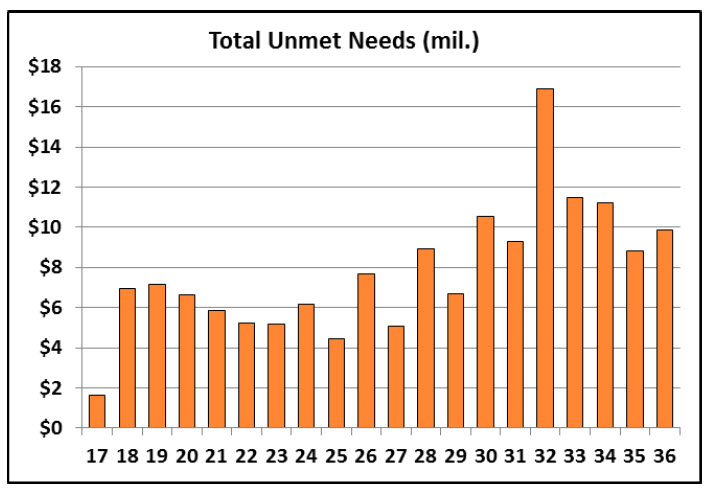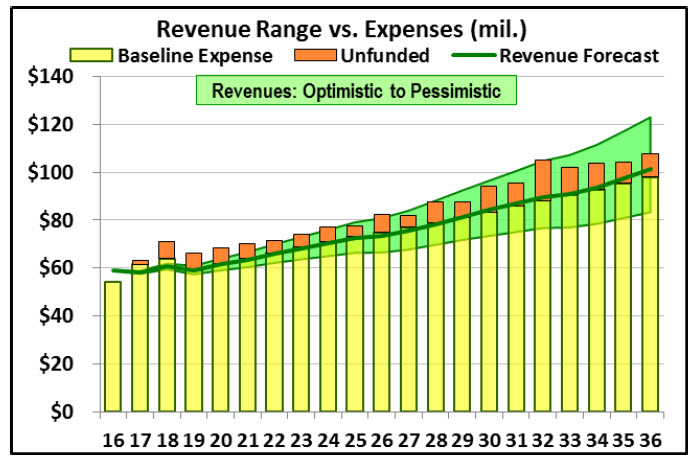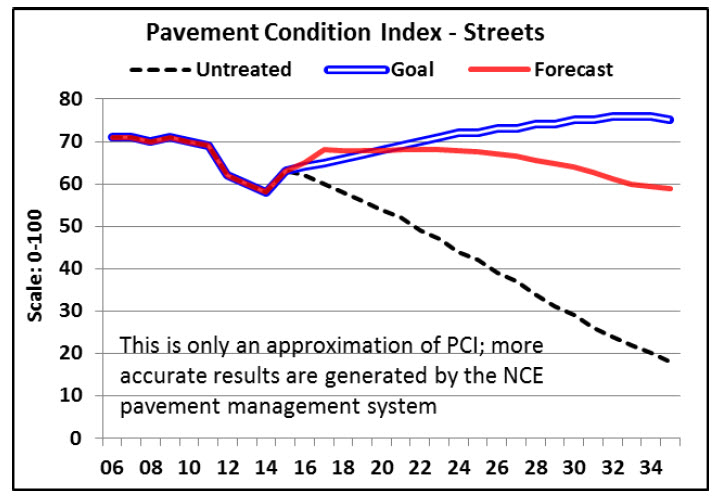
After several years of rosy budget projections, the city, utilizing more robust modeling forecast projections, comes forward with a very sobering and realistic budget analysis.
The report concludes, “The average annual shortfall in funding is $7.8 million.” To put this into perspective, “this amount is roughly equivalent to the current 1% Measure O sales tax, or to a 6.0% utility users tax on power, communications and water/sewer/sanitation services, or to a $270 parcel tax.”
And this is still a low number as the park maintenance cost remains a work in progress.
Here is the chart that shows total unmet needs by year:

This chart shows the unmet need compared to projected expenses, and to the projected revenues including a range of optimistic to pessimistic revenue growth.

Staff writes, “The first observation is that only under a sustained optimistic revenue scenario can a large portion of the unmet needs be funded. The revenue range widens over time with compounding, but in the near term little of the unmet needs would be funded.”
They add, “If revenues are more in the pessimistic range, then not even the projected level of expenses can be sustained – is not reasonable to assume that higher revenue growth will be able to fund these unmet needs.”
Second, “The unfunded portion averages 10% of the General Fund budget. Cutting existing budgets by 10% — a significant amount — to redirect funding to unmet needs, presupposes that the unmet needs are a higher priority than what the City is already doing, which is not likely.”
The source of the city’s budget crunch is not surprising. Pension costs are a major and ongoing source of trouble for the city.
As staff notes, “[W]e are in the midst of a planned multi-year escalation in employer rates by CalPERS.” Pensions payments are expected to double in the next six years.
CalPERS (California Public Employees’ Retirement System), as we have reported, has approved a reduction in its discount rate to 7 percent from 7.5 percent and it was previously at 7.75 percent. Staff notes that “reducing the discount rate results in significant cost increases to employers.” Moreover, staff writes, “this discount rate reduction to 7.0% will probably not be the last; CalPERS officials have been frank in stating that in February 2018 when this issue is next considered, the CalPERS board may well approve an additional discount rate reduction, which will likely be phased in as well.”
The city projects the discount rate to continue to reduce over time, hitting 6 percent by 2041. “An ultimate decline to that level may require multiple actions by CalPERS, and may occur over a shorter period of time,” staff warns.
Once again, costs in 2000-01 were under $500,000 when the pension fund was “superfunded.” Staff projects that payments will peak in about 20 years at $18 million, triple their current level.
The other big portion of this is the infrastructure needs. In 2016, Nichols Consulting projected a 20-year need of $167 million – or $8.3 million annually.
Currently the forecast “assumes that 66% of street costs and 65% of bike path costs, or nearly two-thirds of this need will be funded through a combination of sources: General Fund ($3 million annually ramping up to $5 million in the 2030’s with 85% going to streets and 15% to bike paths), construction tax ($130,000 annually), development fees ($800,000 annually), and the new SB1 gas tax money ($441,000 in 17/18 and $1.56 million annually thereafter).”
The chart shows the Street PCI comparing the goal to the result if the streets are untreated. Currently by the middle of the next decade, the the projected PCI begins to gradually fall to about 60 by FY 35/36.

There are also facility costs. Staff writes, “Kitchell CEM prepared a comprehensive facilities management plan that identified the costs of maintaining and ultimately replacing parks and buildings. They recommended $25 million in maintenance costs over the next 20 years. The forecast projects that 85% of these costs will be met using $1 million in annual General Fund contributions starting FY 18/19.”
As we noted, park maintenance is a work in progress. Staff writes, “This is a work in progress. Parks and Community Services staff has been updating the Kitchell study to better identify park facility needs. The forecast currently assumes an annual average unfunded need of $555,000 for parks and structures, $100,000 for pool equipment replacement, $175,000 for park irrigation/conservation, $250,000 for wildlife habitat maintenance and $100,000 for urban forestry, for a total of $1.18 million.”
Staff notes, “In addition to infrastructure concerns, the City should endeavor to keep staffing levels per capita relatively constant so that workload increases caused by population growth and other service demands can be adequately addressed. This will avoid diminishing levels of service over time.”
Staff adds, “Currently, most services are provided by City employees, but even if services were contracted for, additional funding will be required over time. The forecast funds one FTE increase a year, although two FTE would be required to hold staffing levels per capita constant over time. Thus, 50% of the $87 million in service increase costs over the next 20 years would be funded.”
City Manager Dirk Brazil summarizes the situation in his transmittal letter to the city council. “We continue to see stability in our revenue streams, with notable growth in property and sales tax,” he writes. “Although revenue is currently stable, the City’s expenditure obligations continue to grow. CalPERS announced a change to its pension discount rate over the next three years, effectively increasing the city’s annual pension obligations going forward. While the city continues to fully fund Other Post Employment Benefits (OPEB), also known as retiree medical, those costs will also continue to rise in coming years.”
He continues, “Outside studies show the city needs to commit up to $8.3 million annually toward transportation infrastructure to maintain a suitable pavement criteria index, compared to the $4.4 million proposed for the budget in 2017/18. Finally, the City is in various stages of negotiations with all employee bargaining units, creating some uncertainty related to the 2017/18 budget and beyond.”
—David M. Greenwald reporting







Kudos to those that have lobbied very hard over a number of years to encourage the city to practice transparent, accountable budgeting. The pending Council and community discussion of a $270 parcel tax should prove entertaining.
Michael Bisch said . . . “The pending Council and community discussion of a $270 parcel tax should prove entertaining.”
I agree Michael. Even more entertaining will be the Council and community discussion about any decision with the collective bargaining units during the contract negotiations. What the community and Council and the employees can clearly see now are the tradeoffs that exist when a limited pot of money is deployed to try and cover a set of community needs that significantly exceed the limited funds.
Each dollar spent has multiple alternative uses. It can be spent on repairing the community’s roads, it can be spent on the employees’ pensions, it can be spent on employee retirement medical coverage, it can be spent in current employee salary. The tradeoffs between those competing alternative uses will be transparent for the very first time.
“Each dollar spent has multiple alternative uses” or we can give it as a gift to a few individuals as “Affordable housing”.
Not sure that’s accurate.
How is “Affordable housing” “Affordable” without direct or indirect subsidies?
Should I use the Grande property as an example?
The question isn’t subsidies its whether in this case affordable housing subsidies could be repurposed for other uses and I believe that answer is no.
Considering the history of the affordable housing program managed by the City, I think the comment is completely accurate.
“whether in this case affordable housing subsidies could be repurposed for other uses” you may be correct.
Hasn’t the city been in “various stages of negotiations” for several years now? Seems like that would be the first issue to resolve.
On a side note, my fee for an annual fire inspection has just gone up from $40 to $125. It takes them approximately two minutes.
Can think of only one or two years in the last 40 where that hasn’t been true… only in ~ last 30 years that there have been multi-year contracts. Then there were 5 employee units. Now there are 5, + separate negotiations for each of the department heads (which used to be one “unit”).
2 of the groups (Fire and DCEA) have had no contract for years.
The quoted statement is not only not surprising, it is self-evident.
When I had a single office downtown I had to pay for fire inspection, not the landlord. Believe it was 2 firemen for less than a minute.
Matt, does your modeling agree with this forecast or not apply? What is quoted from City Manager does not sound dire at all, maybe less rosy but not dire?
David. Suggest article on status of various city salary/benefit negotiations. Seems we haven’t heard much in a while. Thx.
I would encourage everyone to read Section 4 of the budget document (Financial Forecast). I think it is a sobering read (and Parks could go higher). It points out how in each area of City infrastructure we are, over the long run, failing to cover maintenance costs. It provides an initial estimate of the size of a potential tax to cover all un/underfunded needs. It is an important read and the kind of analysis this CC has pushed for.
I strongly second Robb’s advice that everyone read Section 4 of the Budget document. Here is a LINK to the online version of that Financial Forecast section, as well as a second LINK to the whole Budget document.
One of the points that Robb doesn’t mention in his comment above is that with the online modeling capability of both Project Toto and the Leland Model, decisions that the Council and the Community face can be examined in the light of the tradeoffs associated with the decision alternatives. For example, when considering any change in employee compensation, some of the alternatives to spending a dollar on a raise in employee pay, are that that dollar can be spent on repairing the community’s roads, that dollar can be spent on the increasing cost of employees’ pensions, that dollar can be spent on the increasing cost of employee retirement medical coverage, that dollar can be spent on maintaining/repairing the City’s parks/pools.
Further, not only can the Council now see the tradeoffs . . . the citizens (collectively and individually) can as well. For example, imagine that you are a PTA parent of two DJUSD students, and the tradeoff being discussed to pay for employee raises is an increased City parcel tax. One of the questions you might ask one another is whether a City Parcel Tax will compete for the same taxpayer dollars as a School District Parcel Tax . . . and whether that means your children’s education will be underfunded.
For Don and Dianne… for each fee, there is a worksheet available for the breakdown of what the fee is based on… it is a public record. Just ask for it.
Fees need to be associated with costs… you might be interested to find out “what is behind” that 2 minute visit.
I don’t need to ask for it, Howard. I’ve looked up the fees online. I’ve been paying it for decades. It was $40. Now it’s $125. There is an additional fee if they have to come back, which they don’t have to do in my case. Other than that, nothing has changed. I know “what is behind” that 2 minute visit. Nothing that warrants a tripling of the fees.
All I can do is suggest you look at the worksheets… part of the tripling could well be (in part) charging for time of the finance department, IS personnel, overhead (perhaps not previously charged) for the program… am not offering an explanation (that’s on you/the City), nor justifying it… am offering you a tool to see for yourself… you can determine appropriateness, and protest, if you see fit.
Great example of ‘criticizing the messenger’, Don.
Sorry for making what I intended to be a useful suggestion. My bad. I should be barred from this blog for my evilness…
The worksheets show times, equipment personnel times expended, hourly rates, etc.
And Don… I’d be shocked if the actual worksheets were posted on-line… huge difference between the worksheets and the fee schedules… but I’m just such an obvious liar, you (justifiably, from your pre-conceived view) can’t trust me on this…
That’s ok.
All City fees were evaluated and increased last year. The default that the CC approved was for each fee to obtain full cost recovery but there are cases (especially in parks/rec programs) in which subsidies are being offered. The full amount of subsidy for each and every fee is available in staff reports.
All fees were discussed and public hearings held. Increasing fees to reflect the cost of service delivery is part of the CC’s efforts to promote fiscal resilience. I know some have gone up a great deal.
Robb, your first sentence should read “Almost all City fees were evaluated and increased last year.” There were/are some fees that were not evaluated, and there are quite a few fees that, after evaluation, saw no increase.
Remind me which fees (a few examples suffice), were not included Matt. I know it was quite comprehensive. Very few held steady and even those with subsidies (in parks/rec) went up.
Development Impact Fees, which are currently being evaluated. It was indeed very, very comprehensive. That is the only exception to the best of my knowledge.
Yes, we are doing those as part of the GP update.